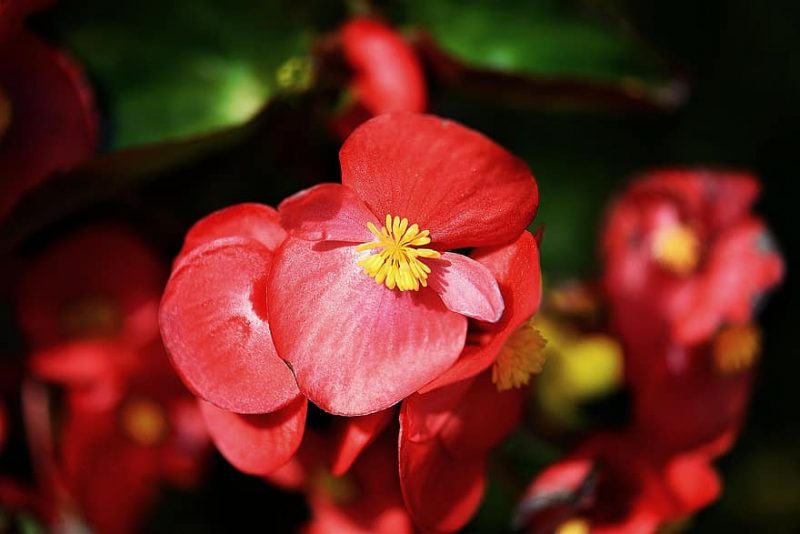These days, almost everyone is engrossed in green projects that gardening is climbing fast on everyone’s list as a favorite hobby, including how to keep begonias blooming.
Be it choosing the best soil or plants to grow best, gardeners always want to know more. Obviously, the web is the go-to resource for these questions. But for begonia lovers out there, this read will share tips on how to keep your lovely babies in full bloom.

The Basics of Begonias
Typically chosen as houseplants, begonias are small in size and are known for their asymmetrical, patterned foliage. Their leaves also add a splash of color to shaded summer beds, making them ideal for creating variety in your garden areas.
Begonias are much renowned for being both aesthetic and easy-care plants. Meaning, you need not exhaust yourself to grow your own variety. They can be grown inside as a houseplant or in full sunlight outside as they aren’t really picky plants.
Indoor Begonias
Choose your variety depending on the characteristic of the plant that you want. Some have tall bamboo-like stems, like the canes. Others have stems attached directly to the plant’s crown, like radish leaves.
Good soil
Go for neutral or slightly acidic soil. A well-draining soil mix is also essential because if the begonia is overwatered, it will easily drop its leaves.
Pot size
Avoid using pots that are too large, as these can make you use too much soil. These would eventually turn soggy and drown the plant roots.
Fertilizer
Application of fertilizer once or twice a month works best for the indoor variety. This will encourage leaf growth and better blooms.
Light requirements
Indoor begonias need to sit in locations that get several hours of bright filtered sunlight. If you’re using fluorescent lighting, place it 6 to 12 inches above the plant and keep it on about half the day. You may need to water the plant more often in this case.
Temperature requirements
The indoor variety needs to have just the right night temperature with a low of 55ºF. These plants thrive well in warmer and more humid environments (roughly 65 to 72 ºF).
Moisture needs
Begonias need a regular watering schedule. They grow best in moist soil but avoid placing the plants in wet or soggy soil as these will lead to root rot. More importantly, let them dry out a bit before watering times and use room temperature water.
Grooming
Prune the plant regularly or as soon as there are dead blooms. Broken stems should also be removed so that the plant can direct its energy on keeping the rest of itself healthy rather than reviving its unwell parts.
Outdoor Begonias
Dark-leaf begonias are ideal for outside gardens. These tuberous hybrid plants need little care and are considered perennials. It’s also worth mentioning that these tubers are resistant to most pests, thus earning them their outdoor title.
Right spot
All outdoor types of this plant have to be in partial shade or in areas with dappled sunlight.
Right soil
For outdoor varieties, it’s a good idea to mix organic matter, along with used coffee grounds, peat moss, and thoroughly rotted compost.
Water needs
Never wet the leaves or flowers. Instead, water the base of the plant until the surrounding soil is evenly moist. Dampness on plants promotes diseases like powdery mildew.
Fertilizer needs
Opt for a balanced fertilizer with 10 percent of each of the macronutrients: nitrogen, phosphorus, and potassium. Include one with trace amounts of micronutrients such as magnesium, calcium, molybdenum, and copper.
Reasons to Plant Begonias and Other Plants in a Greenhouse
Have you ever considered planting your begonias in a greenhouse? There are several reasons why you should try planting your crops, flowers, and other plants in a mini greenhouse, such as:
More plants to grow
With a mini greenhouse, you’ll be able to successfully grow plants that aren’t native to your region. Most greenhouses are typically built to retain heat and humidity so your plants can grow healthy and strong.
Grow your plants longer
The primary advantage of greenhouse gardening is that it provides a longer growing season. As mentioned, much of the sun’s heat is trapped inside the enclosure. Even if you live in colder regions, you’ll be able to extend your growing season with a greenhouse.
Protect your plants from bad weather
Heavy rain, strong winds, high winds, and thunderstorms can easily destroy even the most well-kept gardens. Keeping your plants inside a greenhouse keeps them safe from erratic weather conditions.
Prevent pests from eating your plants
Pests and animals like moles, squirrels, deer, aphids, cabbage worms, and other insects and pests would love to munch on your produce. By growing your plants in a greenhouse and adding traps and screens, you’ll be able to keep these critters away.
Final Thoughts on How to Keep Begonias Blooming
With all the begonia varieties in existence, these plants have become a favorite for lots of gardeners. Whether fibrous, tuberous, canes, or rhizomatous, they are perfect for filling containers, baskets, and even landscapes.
These flowering plants have become appreciated for their stunning appearance and how great they look planted by themselves or with other plants. So, knowing how to keep begonias blooming is an ideal choice for aspiring gardeners and value-focused plant lovers.
